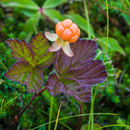mk
имиња во трошки


Cloudberries are inhabitants of Arctic and subarctic regions of the northern temperate zone (Encyclopedia Britannica 2015). Cloudberries are found as north as 78°30' N in Svalbard, Norway and they can be found as south as 44°N in New Hampshire in the United States. It is also very common in northern parts of Norway and can be seen in highland areas and mountains to the south. Cloudberries are also found in many parts of Canada including Alberta, Manitoba, Nunavut, and Quebec. They are widespread in the Northern US and Canada as well.
Cloudberries can handle cold temperatures to as low as -40 degrees Celsius. However, they are extremely sensitive to salt and dry conditions and will not thrive in humid environments. “It grows in bogs, marshes, wet meadows, and tundra, requiring acidic ground (between 3.5 and 5 pH)” (Wikipedia 2017).
Rubus chamaemorus (Cloudberry) is a small plant, stem being 5 to 20cm in height and with its 1 to 3 leaves ranging from 2 to 5cm across and 3 to 7cm long. It possesses a dynamic color sequence as it starts out green, then turns to red, and finishes flowering at an orange-yellow color. It depends on nonflowering reproduction, which takes place underground through the stem or rhizome. Its growth relies on and is most successful in moist or even drier arctic tundras with just enough snow cover to provide protection against harsher weather. (Forbes, 2011)
Male flowers are larger than females but do not produce as much nectar, however little the female flower may produce. Of 43 insect families that visited the cloudberries being studied at the University of Ottawa, the Apidae, Halictidae, Muscidae, and Syrphidae made up 87% of the insects total (Brown, 2009). Although, Dipterans (flies) were found to be the most important pollinator because it is unable to extract the nectar from the competing plant, Ericaceae. This means that flies depend on cloudberries for food and regularly pollinate them. (Brown, 2009)
Rubus chamaemorus (Rosaceae), the Cloudberry, used to have more significance before agriculture, technology, and trade advanced. Cloudberry is thought to be a key part of survival because it is a plant that grows in cold climates such as Russia, Finland, Norway, and Sweden. Someone stranded with no food in these Arctic and Subarctic regions would see a cloudberry as a lifeline due to its edibility and nutrition. Cloudberry flourishes in these climates, making it a key food for survival because it may be the only food around (due to the cold climates) in some locations (Karst 2011). Collection Cloudberry for sustenance was a seasonal cultural tradition to because they were important for survival and were a symbol of life in such cold places. Presently, cloudberries are not a means for survival and aren’t consumed as much as they used to be. Children lack the interest in them and it is very likely that the next generation will continue to lose interest (Karst 2011).
It is necessary to know what cloudberries contain that are essential for survival and improve living conditions. “Cloudberries among other Rubus—berries are rich in ellagitannins, which are complex phenolic secondary metabolites with various positive bioactivities (anti-inflammatory, antimicrobial, antioxidant, and anticancer activities) for human health” (Nohynek 2014). Cloudberries are beautiful plants that have a great history. Though they have lost their importance for survival, they are still highly beneficial in many other ways.
Cloudberries can be found in the northern hemisphere around the world. They grow in cool environments like tundra, boreal forests, and mountain ranges. While there are edible and can be used as a food source, their biggest use comes in the form of their antioxidant properties. This is of huge significance. Once scientific journal produced a study and results from a study in Finland. This is a country located in northern Europe. In the article, the author discussed how berries have been found to have high amounts of phenolic compounds. These compounds have been directly linked to good health. Phenolic compounds are essentially antioxidant components, resulting in less bacteria and healthier food and people. Since Finland is located in northern Europe, it has a large cloudberry population. The cloudberry is very common in the Finnish diet, meaning these people are consuming a lot of antioxidants.
The second set of information came from a different scientific journal. The article talks about the chemical makeup of berries, and why they have antioxidant properties. Raspberries and cloudberries are very high in a chemical compound called ellagitannins. The chemical name for these compounds is very long, but it consists of a chain of chemicals, that when strung together, produce this compound that acts as an antioxidant.